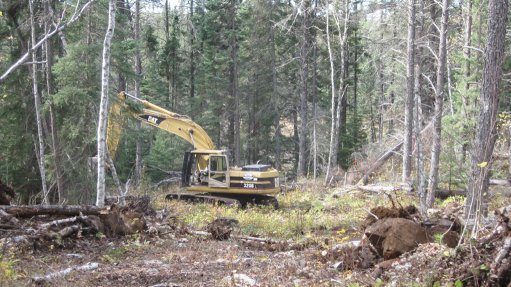
Photo by: Transition Metals
TORONTO (miningweekly.com) – Project generator Transition Metals this week said that a recent drilling campaign at its 50%-owned Sunday Lake project, in Ontario, had increased the known mineralisation.
The Sudbury-based company on Wednesday said that the initial results from three of five holes drilled during April and May totalling 2 550 m, demonstrated the intrusion’s potential to host an economic nickel/copper/platinum group metals (PGM) deposit.
Two of the three holes for which results were available had intersected significant platinum-rich mineralisation including the highest-grade material yet encountered.
Hole SL-14-003 returned two mineralised intervals including a 15 m interval containing 2.84 g/t combined precious metals (platinum/palladium/gold) that included a 1 m interval containing 9.75 g/t PGMs.
“The Sunday Lake intrusion appears to have exceptional prospectivity for hosting economic deposits given the size of the intrusion and thick intersections of high platinum content mineralization. To date the drilling programmes have defined a mineralised corridor that is about 500 m by 200 m in size that remains open in all directions.
“This corridor represents a very small portion of what we believe to be a very large and fertile intrusion,” award-winning prospector and Transition CEO Scott McLean said.
Transition in January first announced that a drilling campaign in partnership with Impala Platinum, at its 50%-owned Sunday Lake project, had confirmed PGMs mineralisation.
TSX-V-listed Transition had previously said that of the six diamond drill holes completed, for a total of 2 546 m, four returned intersections containing significant platinum-rich mineralisation, including hole SL-13-002, which intersected 20.2 m containing 3.22 g/t of PGMs.
The company had found a large intrusion similar to other intrusions in the Midcontinental Rift (MCR). The MCR is a 2 000-km-long geological rift in the centre of North America that formed when the North American craton began to split apart about 1.1-billion years ago.
Other intrusions in the area that are known to be mineralised include Panoramic Resources’ nearby Thunder Bay North PGM project, Rio Tinto’s Tamarack, in Minnesota, and Lundin Mining’s Eagle mine, in Michigan, to which the Sunday Lake project had shown similarities.